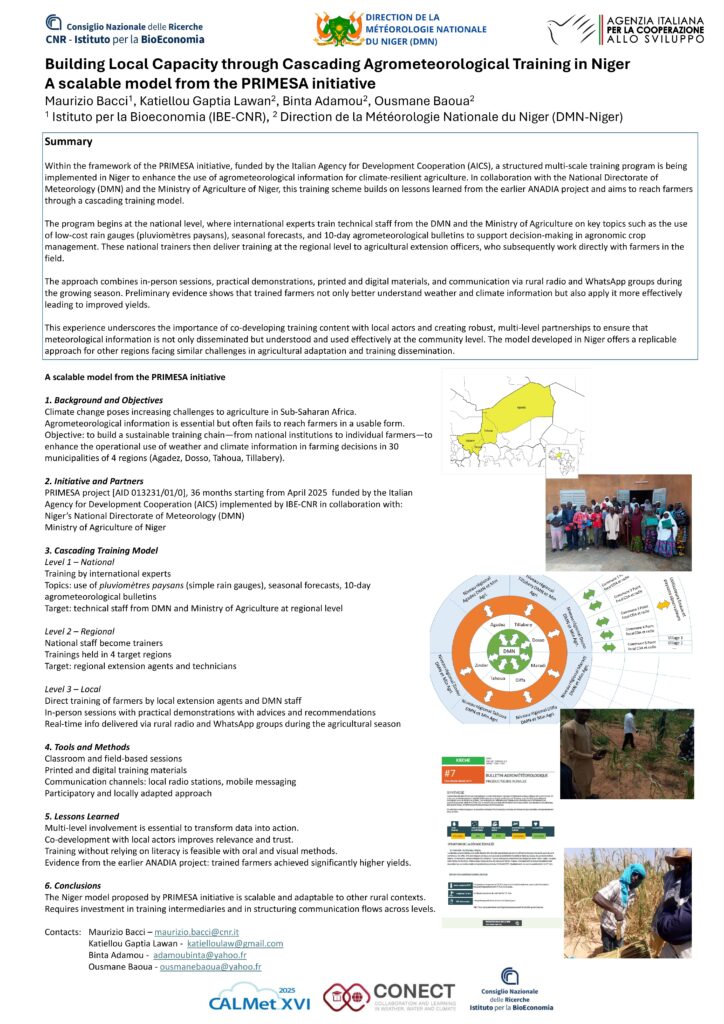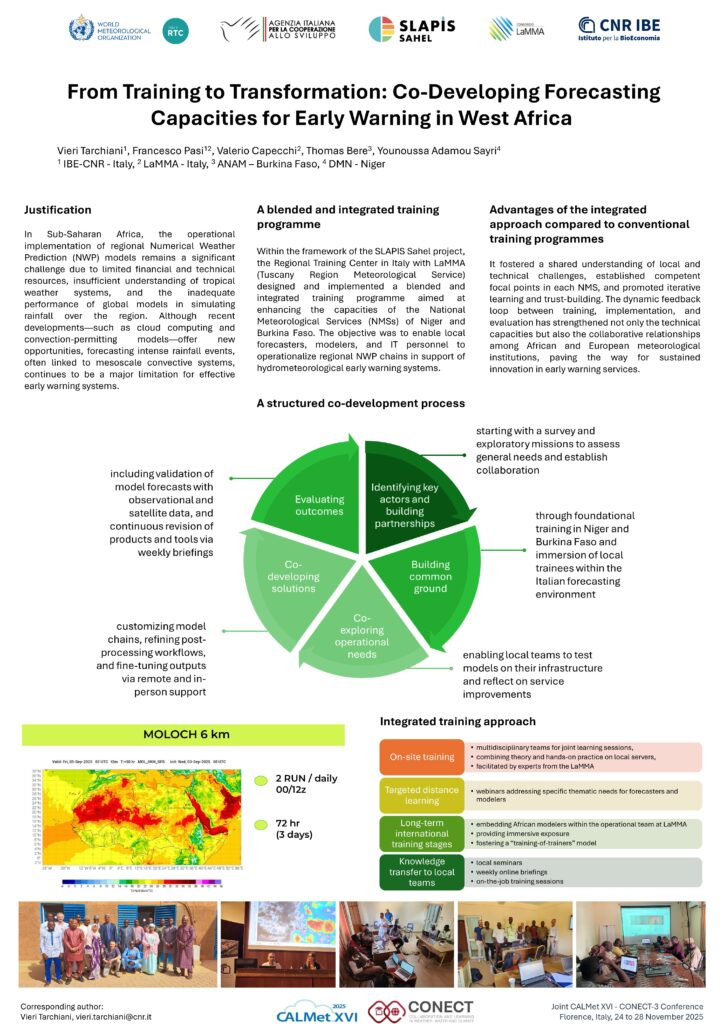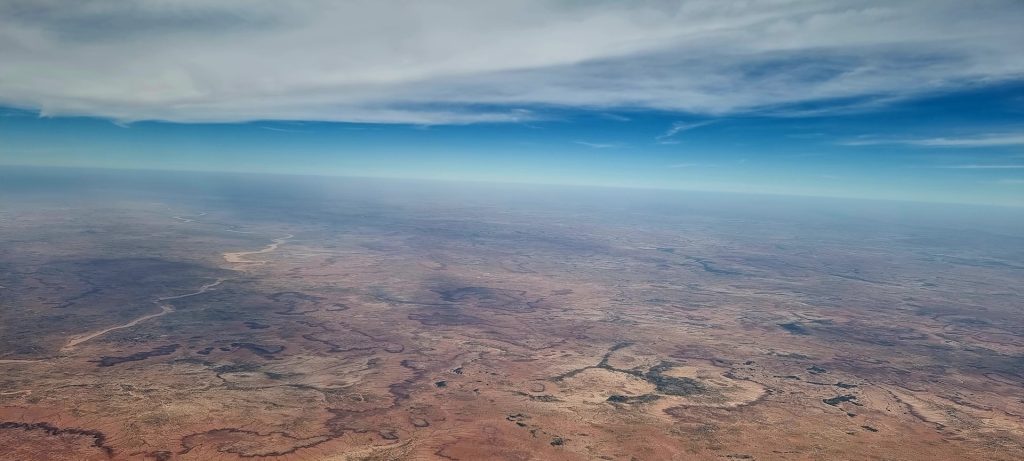Building Local Capacity through Cascading Agrometeorological Training in Niger A scalable model from the PRIMESA initiative

Within the framework of the PRIMESA initiative, funded by the Italian Agency for Development Cooperation (AICS), a structured multi-scale training program is being
implemented in Niger to enhance the use of agrometeorological information for climate-resilient agriculture. In collaboration with the National Directorate of
Meteorology (DMN) and the Ministry of Agriculture of Niger, this training scheme builds on lessons learned from the earlier ANADIA project and aims to reach farmers through a cascading training model.
The program begins at the national level, where international experts train technical staff from the DMN and the Ministry of Agriculture on key topics such as the use
of low-cost rain gauges (pluviomètres paysans), seasonal forecasts, and 10-day agrometeorological bulletins to support decision-making in agronomic crop
management. These national trainers then deliver training at the regional level to agricultural extension officers, who subsequently work directly with farmers in the
field.
The approach combines in-person sessions, practical demonstrations, printed and digital materials, and communication via rural radio and WhatsApp groups during
the growing season. Preliminary evidence shows that trained farmers not only better understand weather and climate information but also apply it more effectively
leading to improved yields.
This experience underscores the importance of co-developing training content with local actors and creating robust, multi-level partnerships to ensure that
meteorological information is not only disseminated but understood and used effectively at the community level. The model developed in Niger offers a replicable
approach for other regions facing similar challenges in agricultural adaptation and training dissemination.
From Training to Transformation: Co-Developing Forecasting Capacities for Early Warning in West Africa

In Sub-Saharan Africa, the operational implementation of regional Numerical Weather Prediction (NWP) models remains a significant challenge due to limited financial and technical resources, insufficient understanding of tropical weather systems, and the inadequate performance of global models in simulating rainfall over the region. Although recent developments—such as cloud computing and convection-permitting models—offer new opportunities, forecasting intense rainfall events, often linked to mesoscale convective systems, continues to be a major limitation for effective early warning systems.
Within the framework of the SLAPIS Sahel project, a development cooperation initiative, the Regional Training Center in Italy designed and implemented a blended and integrated training programme aimed at enhancing the capacities of the National Meteorological Services (NMSs) of Niger and Burkina Faso. The objective was to enable local forecasters, modelers, and IT personnel to operationalize regional NWP chains in support of hydrometeorological early warning systems.
Slapis Sahel Numerical Weather Prediction

SLAPIS SAHELProject Numerical Weather Predictionin SLAPIS Sahel One of the key objectives of the SLAPIS Sahel project is to strengthen national capacities in Numerical Weather Prediction (NWP) as a support for hydrological early warning, particularly for flash floods and flooding events along the Sirba River and the Niger River. The national meteorological agencies of Niger […]
DEM Generation from Multi-View Satellite Images in Sub-Sahel Region
Floods are causing a significant loss of human lives and valuable resources in West Africa. In particular, Niger and Burkina Faso were highly affected areas in past years. In order to predict flood, an accurate Digital elevation model (DEM) is required for flood mapping. At the studied area in Niger, up to this date, the […]
Bridging the communication gap in agrometeorological services: Enhancing the uptake and effectiveness for users in developing countries
Over the past decades, advancements in agrometeorological monitoring and forecasting have been driven by technology, infrastructure, and capacity building. Literature highlights that agrometeorological services support agricultural decision-making, boosting farmers’ resilience and income globally. However, challenges in communication and dissemination limit their effectiveness, particularly for smallholder farmers in remote areas. The problem extends beyond media type […]
Flood risk assessment of agricultural areas along the Niger river upstream Niamey
Much of the food supplied to the city of Niamey (1.5 million inhabitants), the capital of Niger, comes from 150 large commercial horticultural sites and 10 vast irrigated perimeters distributed along the Niger River upstream of the city. These areas are threatened by floods, such as the one that devastated paddy fields and horticultural areas […]
Flood Damage Risk Mapping Along the River Niger: Ten Benefits of a Participated Approach
Flood risk mapping is spreading in the Global South due to the availability of high-resolution/high-frequency satellite imagery, volunteered geographic information, and hydraulic models. However, these maps are increasingly generated without the participation of exposed communities, contrary to the Sendai Framework for Disaster Risk Reduction 2015–2030 priorities. As a result, the understanding of risk is limited. […]
Compound-event analysis in non-stationary hydrological hazards: a case study of the Niger River in Niamey
This study examines compound hydrological hazards in a non-stationary context, specifically focusing on the Niger River in Niamey. The hazard results from the confluence of local Sahelian and more remote Guinean tributaries, displaying seasonal floods. The study first investigates whether Niamey’s annual flood hazard is a compound result of Sahelian and Guinean flows, and then […]
Geospatial Capacity Building for Flood Resilience in the Sahel: the SLAPIS project case study
This study focuses on the development of a people-centred early warning system (EWS) against floods in the Sirba River basin between Niger and Burkina Faso. This densely populated area has witnessed an increase in extreme flooding events in recent years. Several flood forecasting systems in the Sahel exist, although there is no EWS that integrates […]
Comparative Trend Analysis of Precipitation Indices in Several Towns of the Sirba River Catchment (Burkina Faso) from CHIRPS and TAMSAT Rainfall Estimates
The increasingly frequent pluvial flood of West African urban settlements indicates the need to investigate the drivers of local rainfall changes. However, meteorological stations are few, unevenly distributed, and work irregularly. Daily satellite rainfall datasets can be used. Nevertheless, these products often need to be more accurate due to sensor errors and limitations in retrieval […]


